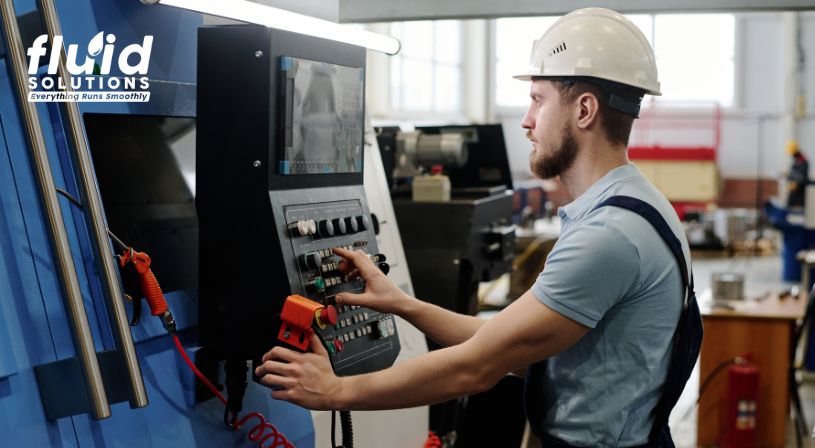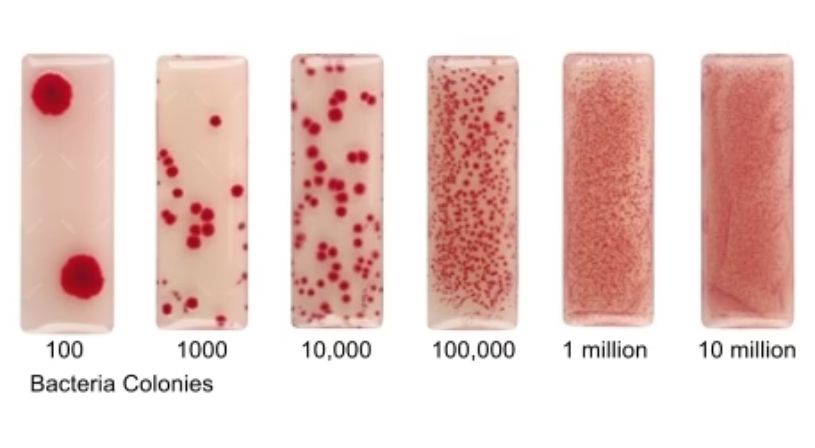
Source: https://www.freepik.com/premium-photo/man-operating-cnc-machine_154059003.htm
Nothing kills the morale of a CNC machine operator faster than walking into the shop on a Monday morning, only to be greeted by the unmistakable and dreaded pungent coolant smell. The foul odor, often compared to dirty socks, towels, and rotten eggs, can quickly spread throughout the shop floor, creating an unpleasant working environment. Bacteria in coolants typically cause this stench, and while it may seem unavoidable, it can be controlled and prevented with the right practices.
Below are some practical steps that machine operators can follow to prevent bacteria in coolant from wreaking havoc on their operations:
- Use Clean Water and Containers. Always use clean water and containers, such as pails and drums, when handling water-soluble oil cutting fluids to prevent contamination. Contaminated water is often a breeding ground for bacteria, which can quickly lead to foul odors and poor coolant performance.
- Keep Dedicated Containers and Tools for Each Fluid Type. Have dedicated containers, hand pumps, dippers, and other paraphernalia for each type of metalworking fluid and lubricant. This prevents cross-contamination, which can introduce bacteria and fungi into your coolant. Never interchange the use of these items between different fluids, as this can lead to coolant breakdown and bacterial growth.
- Maintain the Correct Coolant Concentration. Always follow the manufacturer’s recommended concentration when mixing water-soluble oil cutting fluid. At the proper concentration, the coolant will contain enough biocides to combat bacterial growth. Skimping on concentration weakens the coolant’s ability to resist bacteria, leading to the unpleasant smell of coolant that operators dread.
- Monitor pH Levels and add a pH Booster. The pH level of the coolant is an important indicator of its ability to prevent bacterial growth. When the pH drops below 8.7, the coolant becomes more susceptible to bacteria and fungi. Adding a pH booster or alkalinity improver can help raise the pH to an optimal range of 8.8 – 8.9, an environment that is hostile to bacterial activity.
- Remove Tramp Oil Regularly. Tramp oil removal is essential to maintaining coolant health. Tramp oil, such as leaked slideways or hydraulic oils, floats on the surface of the coolant, preventing oxygen from reaching the fluid. This creates an anaerobic environment where bacteria thrive. To prevent this, skim tramp oil off the surface manually with a dipper or foam or use an automated belt skimmer. Regular tramp oil removal helps oxygenate the coolant and reduces bacterial growth, minimizing the chance of foul odors.
- Keep the Fluid System Aerated During Long Breaks. During long breaks or weekends, coolant that remains stagnant can quickly become a breeding ground for bacteria and fungi. To prevent this, keep the system aerated by circulating the fluid at intervals. Alternatively, injecting compressed air into the coolant can help oxygenate the fluid and prevent anaerobic bacteria from thriving.
- Remove Chips and Metal Fines from the Sump. Bacteria accumulate and thrive in the chips and metal fines that settle at the bottom of the machine sump. Regularly removing this debris helps reduce bacterial growth and ensures a cleaner, more efficient coolant system. Cleaning out the sump periodically will not only prevent coolant smell but also prolong the life of your coolant and machine.
- Consider Biocide Doses for Persistent Issues. If the steps above do not fully resolve coolant issues, consider adding a dose of biocide directly to the fluid. A concentration of 0.01 – 0.02% biocide is typically enough to kill off bacteria, but it’s important to remember that biocides are highly acidic. Only trained personnel should handle biocides, and they should always use personal protective equipment (PPE), such as nitrile gloves and safety goggles.
Handling Fungal Contamination in Coolant
While the steps above can help prevent both bacteria and fungi, fungi are more persistent once they become present in the system. Signs of fungal contamination include slime and scum lining the walls of the machine, floating on the surface of the coolant, or even blocking coolant pipes. Biocides can be effective in killing fungi, but the physical removal of slime and scum is essential for restoring coolant performance.
Periodic Monitoring with Agar Slides

Source: https://lotioncrafter.com/products/microbial-test-kit-10-pack

Source: https://lotioncrafter.com/products/microbial-test-kit-10-pack
For those looking to take extra precautions, some invest in periodic bacterial and fungal population checks using agar slides. These slides help identify bacteria and fungi, allowing operators to address problems before they become severe. The yellow side with red dotted growth shows bacteria in oil, while the red side with white splotches points to fungal contamination.
While this method may be more expensive, it provides a clear visual representation of microbial activity, enabling operators to take preventive measures before odors or other problems arise.
Eliminate Coolant Issues with Fluid Solutions’ Expert Products and Guidance
Tired of dealing with coolant issues in your shop? Fluid Solutions provides top-of-the-line products and expert guidance to help you eliminate coolant problems, extend sump life, and maintain a cleaner, more efficient workspace. From water-soluble cutting fluids to hydraulic oils, grease lubricants, and anti-rust solutions, we have everything you need to keep your machines running at their best.
Reach out to Fluid Solutions today at (02) 8370 5928 / (0917) 894 9156 or email us at inquiry@fluidsolutions.com.ph to learn more about how we can help you optimize your coolant systems and reduce downtime caused by bacterial growth or tramp oil.


